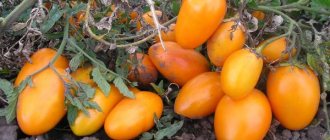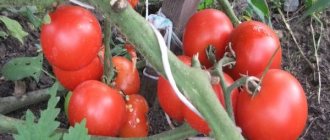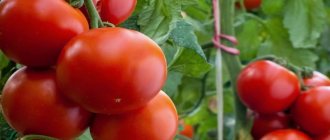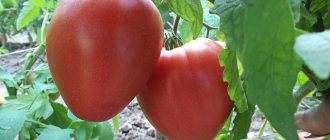Characteristics and description of the tomato variety Alpatieva
Tomato Alpatieva 905 is an unpretentious and popular variety of tomatoes, which is excellent for both canning and fresh consumption.
The standard variety Alpatieva belongs to the early ripening determinate varieties. His main merit is his unpretentiousness. Even people who have never gardened in their lives can successfully grow this variety. Even novice gardeners can enjoy fresh tomatoes from their garden without much effort.
Characteristics of this variety
This variety of tomatoes is a low bush (no higher than 50 cm), very compact and does not require pinching or staking. 4-5 such bushes fit on one square meter. The foliage of the bushes is strong, the stems are erect. The leaves are medium-sized, rich green in color, corrugated. Simple inflorescences, neat and small, form on the branches. 3-6 inflorescences are formed on the central stem, the first inflorescence is formed above the 7-8 leaf, the next ones - every 1-2 leaves.
The fruits have a regular round shape, slightly flattened. Bright scarlet color. The size of the fruit varies from 60 to 100 grams. Each vegetable contains 4 nests. The surface of the vegetable is smooth. The taste cannot be called excellent, but it can be called satisfactory. If you want to please yourself with a fresh tomato salad, but at the same time you are very picky about taste, then such tomatoes are unlikely to surprise you with anything.
But they are quite suitable for canning. The tomatoes are compact and uniform in size, resistant to cracking and look great in jars, unlike other varieties that are more tasty and fleshy, but also larger and unsuitable for winter storage.
The main value of this variety is industrial. This variety is very productive. During the fruiting season, it is possible to collect 2-2.5 kg of ripe tomatoes from one bush. Harvesting begins 100-110 days after planting the seeds.
The declared characteristics of this variety indicate the possibility of its cultivation in open soil, both in the central zone of our country, and in the Ural Territory and even in Eastern Siberia.
It is important to know! Tomatoes have very beneficial properties for the human body, but unlike other vegetables, in tomatoes these properties are much stronger when boiled. Therefore, among the many juices, the only tomato juice is recommended to be taken in digested form, and not freshly squeezed.
The advantages of this variety of tomatoes
The advantages of Alpatiev tomatoes are obvious:
- Simultaneous ripening of fruits. In the first 14 days, up to 30% of the total crop ripens. This is very convenient for winter canning.
- Tomatoes can withstand sudden temperature changes well.
- Drought resistance and unpretentiousness in cultivation and care.
- The possibility of growing this variety from your own seeds. This variety is not a hybrid, which allows you to save on purchasing seeds. To collect your seeds, you need to leave a few vegetables on the bush until they are completely ripe (until soft). Then the fruits are ground through a sieve, the seeds are washed, dried and left in a secluded place until next spring.
The Alpatieva 905 a tomato variety contains special sugars that open up and give the tomatoes an original taste when salted.
The description of this variety indicates the high resistance of the plant to various pests and diseases.
Features of cultivation
This variety of tomatoes does not require any special conditions or manipulations when growing them. The plant can be planted both in open ground and in a greenhouse. Further care involves timely but not frequent watering, weed removal, fertilizing and loosening the soil.
If you decide to start growing Alpatiev tomatoes, then without much effort you will provide yourself and your loved ones with delicious canned tomatoes for the whole winter.
Diseases and pests
| Apical rot The cause of rotting and wilting of bushes is a lack of potassium in the soil. Ways to fight:
| |
| Phytoplasmosis Fruits, leaves, and flowers are affected by the smallest microorganisms. Ways to fight:
| |
| Pests: whitefly, spider mites, aphids Ways to fight:
|
Tomato Alpatieva
Tomato Alpatieva 905A was bred at VNIISSOK by crossing the varieties Shtambovy Alpatieva 905 and Bison 639. It was included in the State Register of Breeding Achievements of Russia back in 1950. It can be planted and grown even in the Urals and eastern Siberia. It is planted in an open area and in a greenhouse.
Characteristics and description of the tomato variety Alpatieva
Early variety. You can harvest tomatoes 100–115 days after sprouts appear. This is not a hybrid. The bushes reach a height of 0.5 m.
The stems stand straight. The foliage is highly corrugated and has a dark green tint. The first fruit cluster grows above the 7-8 leaf, the second and subsequent ones - after 1-2 leaves. 3-4 fruits ripen on one cluster.
Note! The bushes are standard, that is, stepsons do not grow on them.
Description of Alpatiev tomatoes
The fruits are round, slightly flattened, bright scarlet. Fruit weight is 60-100 g. The tomato has 4 seed chambers. It contains 5-6% dry matter and 2.6-3% sugars. It is convenient to preserve and pickle fruits, since they are smooth, do not crack, and are similar to each other. They contain special sugars that give a unique flavor when pickled. You can squeeze tomato juice.
The yield of Alpatiev tomatoes is high - up to 2-2.5 kg are harvested from 1 bush, and 146-445 centners from 1 hectare.
General information about the variety
Alpatiev 905 tomatoes are low-growing, growing up to half a meter, no more. The bushes are formed very compact and do not require any pinching or gartering of branches. Up to five bushes are planted per 1 m2 of area. The stems of this variety grow strictly vertically, they are densely covered with bright green fronds. The shape of the small leaves is corrugated.
The fruits are round, noticeably flattened in shape - as you see in the photo. Their color is bright red or even scarlet. They weigh a little, from 60 to 100 grams. The tomato pulp is divided into 4 segments.
Ask and receive useful advice from professional gardeners and experienced summer residents.>>
As for taste, Alpatiev tomatoes do not have an exquisite taste. However, as they say, there are no comrades according to taste.
Canned Alpatiev tomatoes are much tastier. In addition, as housewives write in reviews, they withstand heat treatment.
The main value of this variety is the possibility of growing it on an industrial scale for further processing.
Tomato 'Alpatieva 905 A'
Latin name: solanum lycopersicum 'alpateva 905 a'
Main genus: Tomato
| Productivity |
|
| Ripening period |
|
| Soil type |
|
| Growing method |
|
| Purpose of fruits |
|
| Disease resistance |
|
| Soil ph requirements |
|
| Life form |
|
| Shape of fruits/stems/roots and tubers/heads |
|
| Size of fruits/stems/roots and tubers/heads |
|
| Cultivation region by origin |
|
| Vitamin content |
|
| Color of fruits/roots and tubers | |
| Peel thickness |
|
| Frost resistance |
|
| Drought resistance |
|
| Decorative value |
|
| Taste of fruits |
|
| Shelter for the winter |
|
| Pest resistance |
|
| Habit |
|
| Keeping quality |
|
| Parthenocarpic |
|
| Branching pattern |
|
| Density and character of the pulp |
|
Expand all properties
Description of the plant:
Tomato 'Alpatieva 905 A' is a variety bred by the All-Russian Research Institute for Selection and Seed Production of Vegetable Crops. Approved for use in the North-Western, Central, Volga-Vyatka, Ural and East Siberian regions in 1950.
Recommended for growing in open ground.
Dimensions and growth form:
The variety 'Alpatieva 905 A' is represented by standard, determinate, erect plants. The foliage is strong. The height of the main stem is 32–44 cm. The leaf is medium-sized, dark green, highly corrugated.
The inflorescence is simple, compact, short (6–9 cm). The first inflorescence is formed above the 6-8th leaf, the subsequent ones - after 1-2 leaves. There are 3–6 inflorescences on the main stem.
Fruit:
Size, shape and color:
The fruit is flat-round and round in shape, medium in size, weighing 55–75 g. The surface is smooth and slightly ribbed. The color of the unripe fruit is green, with a dark spot at the stalk; the color of the ripe fruit is red. The number of nests is 3–6, the location is correct.
The taste of the fruit is satisfactory.
Ripening time and yield:
Tomato 'Alpatieva 905 A' is an early ripening variety. The period from full germination to fruit ripening is 100–115 days. Productivity 1.4–4.4 kg/m2.
Directions for use:
Recommended for fresh consumption and pickling.
Advantages of the variety
- Harmonious ripening of fruits.
- The variety, according to its characteristics, practically does not react to sudden changes in ambient temperature.
- Easy to care for.
- Drought resistance.
- Possibility to use your own seeds for seedlings. For this, it is important to take them only from overripe fruits. Dried seeds are completely preserved until spring in paper or fabric containers.
- High content of sugars in the fruit pulp.
- Good yield.
Early tomatoes for open ground
In terms of ripening time, tomatoes for open ground are of particular interest, ripening in the early and middle stages. Early, super-early, ultra-early and early-ripening varieties include such “hurry-up” varieties that manage to please with the first harvest in less than 3 months after emergence. The clear leaders in terms of ripening speed are undoubtedly Alpha (2004), Amursky Shtamb (2010), Aphrodite (2008) and Benito (2000). Also among the quickly ripening varieties are Barmaley, Ashkelon, Pink Tsar, Sweet Girl, Agata.
Tomato Amur standard
From sowing the seeds of the Amur standard to the first eaten tomato, it will take 85-95 days in open ground. This is an excellent salad variety that is also quite suitable for canning. The fruit has a flat-round shape, a slightly ribbed surface and a dense skin. Ripe fruits are red. The number of nests can be from 4 to 6 pieces. The weight of the fruit is no more than 70 g, and the taste is simply perfect. Productivity up to 5 kg/m2.
Tomato Aphrodite
Five days earlier, Aphrodite will give you its fruits; this is a salad variety with a rounded fruit shape, a smooth surface and medium density. Fully ripe fruits are scarlet.
There can be from three to four nests. The weight of the fruit varies from a hundred grams to almost one and a half hundred. The taste is excellent, and the yield is up to 8 kg/m2.
Tomato Benito
The Benito variety will produce a harvest a full ten days earlier; it can be eaten fresh or used for various types of processing.
The fruits are interesting - cuboid in shape with only slightly noticeable ribs. Ripe fruits are almost perfectly red. Nests from two to three. The weight of the fetus can vary greatly from forty grams to hundreds. The taste is simply amazing.
Advantages and disadvantages
The review summarizes the positive characteristics of the species and notes some negative aspects. Here are the advantages of the hybrid:
- high fruiting rate;
- ease of care;
- ability to settle down in any region;
- immune to diseases;
- does not require pinching;
- excellent taste of fruits;
- marketable condition;
- long-term storage;
- long-distance transportation;
- versatility in cooking.
READ MORE: Lunar sowing calendar for gardeners and gardeners for 2020, table of favorable days
Negative sides:
- requires mandatory garter;
- poor tolerance to insufficient or excessive watering.
Pros:
- versatility;
- productivity;
- excellent taste characteristics;
- tolerance to low temperatures and frosts;
- resistance to heat and drought;
- simple agricultural technology.
Minuses:
need for a good sunny place; the importance of fertilizing.
Neither breeders nor ordinary gardeners speak in detail about tomato yields in online reviews. The State Variety Commission certificate mentions a value of about 5 kg of marketable fruits per 1 sq. m. In this case, the variety is called high-yielding. General list of advantages:
- Convenient fruit size for various culinary tasks. Some specimens reach a weight of 250 g. On average, the harvest is smaller.
- Good taste and high-quality pulp structure. Tomatoes are used for fresh salads, canning, and processing into sauces and juices.
- Early maturation.
- Unpretentiousness to growth and care conditions. The tomato bears fruit normally even in bad weather. It can also be grown without additional measures: pinching and gartering.
- Increased resistance to late blight.
Attention! There is no official information about the culture's resistance to other diseases. Cons of tomato Tatyana:
Cons of tomato Tatyana:
- keeping quality is not high enough for long-term storage and transportation of ripe crops;
- with excessive watering, the tomato skin bursts right on the bushes;
- the plant tends to grow green mass - the lower leaves will have to be torn off from time to time;
- Due to the small number of seeds in the pulp, it is labor-intensive to propagate the crop at home.
The taste characteristics of fruits should be assessed with a discount for early ripening.
Description of the hybrid
Palenca is a hybrid, not a tomato variety. Its characteristics and description indicate high productivity even in unfavorable conditions. The plant is indeterminate, with unlimited growth of the main stem.
The height reaches 2 m and therefore requires gartering and pinching of plants. The foliage is medium, the leaves are rich green, the branches are spreading. The first flower cluster is placed above the 9th leaf, subsequent ones every 2-3 leaves. Each brush produces 5–7 ovaries in all weather conditions.
Mid-early species: harvesting begins 105–115 days after emergence. Tomato is immune to a number of dangerous diseases, such as:
- tobacco mosaic virus;
- fusarium and verticillium leaf wilt;
- cladosporiosis (brown spot);
- root rot.
These diseases have different etiologies: viral and fungal. Both are equally dangerous for plants. During an outbreak of infections, most of the plantings die. When damaged by fungi, seedlings can be cured by identifying the disease at an early stage. However, a viral infection is practically untreatable. Therefore, a big plus for any culture is its immunity.
In addition, neighboring plants can also become infected, as happens with brown spot, tobacco mosaic, fusarium and verticillium. With these diseases, the appearance of the leaves and their color are modified. Subsequently they wither and the plant dies. Root rot causes rotting of the roots and death of stem tissue.
Despite Palenca's strong immunity against many dangerous diseases, it is practically not protected from late blight. Therefore, you should take care of the necessary preventive measures in advance.
Yield indicators
The culture is recommended for cultivation under film cover and in greenhouse conditions. Nevertheless, in the southern regions, tomatoes are successfully grown in open beds, although under such conditions high fruiting rates cannot be achieved.
When planted in a greenhouse, 6-7 kg of excellent fruits are collected from 1 seedling, provided that no more than 3 plants are planted per 1 m2.
Description of fruits
The photo shows Palenque tomatoes. The average weight of ripe tomatoes is 100–130 g, oval in shape, slightly elongated, similar to cream. The color is deep red, the taste is excellent, sweet, with a pronounced sourness characteristic of tomatoes.
The pulp is juicy and dense. The peel is thin, but strong enough for long-distance transportation. During long-term storage, vegetables retain their presentation. For these reasons, the variety is a success among entrepreneurial farmers who grow it on an industrial scale. Ripe tomatoes are in great demand in markets.
The purpose of the fruits is universal: they are suitable for preparing various fresh dishes, winter preparations and processing into tomato products.
Growing rules
Caring for Alpatiev 905 tomatoes is simple and easy. Tomatoes can be grown in beds, fields and greenhouses. The essence of care is really necessary and moderate watering, timely weeding, loosening the soil and regular fertilizing.
Most often, it is not necessary to tie up the stems of Alpatiev 905 tomatoes. Only sometimes in some bushes too many fruits are formed, then the stems are tied to a support. There is no need to do stepsoning.
There is a small peculiarity in caring for this variety. You need to start hardening off seedlings not a week before planting in the ground, but 10 days before. In addition, during seedling growth, it needs to be fed two or three times with complex mineral fertilizers.
Seedlings are planted in the ground after the threat of spring frosts has disappeared. The distance between bushes should be at least 40 cm, and between rows - at least 50 cm.
When the bushes reach a height of 15–20 cm, the lower leaves are torn off. This is done so that air does not stagnate at the base of the trunks. As you know, poor air circulation contributes to the appearance of fungal diseases.











